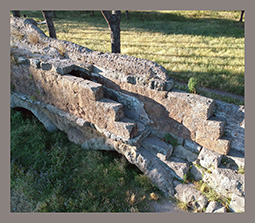Autore: P. Montanari
Scarica l’articolo in formato .pdf: Aqua Marcia: per il cocciopesto un’applicazione sperimentale
 Una recente indagine sul tratto di Aqua Marcia conservato nel Parco degli Acquedotti, condotta dal luglio al settembre 2019, ha portato alla scoperta di un nuovo uso del cocciopesto. In aggiunta al manto di cocciopesto di cui è rivestito lo specus, gli architetti romani del II secolo a.C. usarono la medesima mescola di frammenti di tegole, pozzolana e sabbia per un differente scopo: realizzare un ulteriore sistema impermeabilizzante. Lungo le facce laterali di contatto di ogni concio murario del condotto, verticalmente, al centro, corre un incavo riempito di cocciopesto. Senza dubbio, tale tecnica edilizia appartiene alla prima fase edilizia dell’acquedotto (144 a.C.) e sembra costituire la sua più antica attestazione in monumenti in opus quadratum. Sia l’Aqua Appia sia l’Anio Vetus, per quel che si sa, non presentano quest’applicazione. Quantunque il cocciopesto abbia fatto la sua comparsa molto tempo prima, come dimostrato, ad esempio, nel Latium Vetus dal Segni Project, possiamo sostenere che l’Aqua Marcia offre una rivoluzionaria soluzione: l’uso del cocciopesto all’interno degli incavi, aggiunto al rivestimento dello specus, garantì all’infrastruttura un eccezionale potere impermeabilizzante.
Una recente indagine sul tratto di Aqua Marcia conservato nel Parco degli Acquedotti, condotta dal luglio al settembre 2019, ha portato alla scoperta di un nuovo uso del cocciopesto. In aggiunta al manto di cocciopesto di cui è rivestito lo specus, gli architetti romani del II secolo a.C. usarono la medesima mescola di frammenti di tegole, pozzolana e sabbia per un differente scopo: realizzare un ulteriore sistema impermeabilizzante. Lungo le facce laterali di contatto di ogni concio murario del condotto, verticalmente, al centro, corre un incavo riempito di cocciopesto. Senza dubbio, tale tecnica edilizia appartiene alla prima fase edilizia dell’acquedotto (144 a.C.) e sembra costituire la sua più antica attestazione in monumenti in opus quadratum. Sia l’Aqua Appia sia l’Anio Vetus, per quel che si sa, non presentano quest’applicazione. Quantunque il cocciopesto abbia fatto la sua comparsa molto tempo prima, come dimostrato, ad esempio, nel Latium Vetus dal Segni Project, possiamo sostenere che l’Aqua Marcia offre una rivoluzionaria soluzione: l’uso del cocciopesto all’interno degli incavi, aggiunto al rivestimento dello specus, garantì all’infrastruttura un eccezionale potere impermeabilizzante.
A recent analysis of the Aqua Marcia situated into the Parco degli Acquedotti of Rome (July-September 2019), near the Casale di Roma Vecchia, has lead to the discovery of a new use of cocciopesto. In addition to the cocciopesto coating applied to the specus, Roman architects of the 2nd cent. BC used the same mixture of tile fragments of pozzolana, lime and sand for a different purpose: creating a further waterproofing system. Along the short side of every block of the duct, into the middle, rises a vertical groove filled with cocciopesto. As a matter of fact, this work belongs to the first phase of the aqueduct (144 BC) and seems to represent the oldest manifestation of this particular use in an opus quadratum monument. Both the Aqua Appia and the Anio Vetus, to the best of our knowledge, do not display this construction technique. Although the cocciopesto made its appearance long time before, as shown, for example, in Latium Vetus, by the Segni Project, we can argue that the Aqua Marcia presents a revolutionary solution: the use of cocciopesto within the flutes, added to the linings of the channel, gave the work an extra waterproofing power.
